I really like my FlexRadio! I had a 6400 for a year before an opportunity arose in 2022 to purchase a used 6700. I’m a MacOS user so I use the excellent SmartSDR from Marcus Roskosch with an Icom RC-28 controller and a Heil PR781 microphone. This setup has served me well on HF, even with my restricted antenna setup on those bands.
Since getting on to QO-100 I’ve used an Icom IC-9700 with my DX Patrol Full Duplex Groundstation (1.0) before building an SDR setup (Pluto+ and SG Labs amplifier).
With my ‘SDR Box’ I used SDR Console, another fantastic piece of software and was the only thing which has managed to convince me to run Windows (in a VM on my Mac) in decades.
I missed using my FlexRadio though so I decided to figure out how I could use it with my Groundstation.
The groundstation will accept inputs on 10m, 6m, 2m, 70cm and 23cm with a minimum of 500mW (optimal is 1W) and a maximum of 5W. I could use one of the two ANT ports on the FlexRadio to drive this but I didn’t want to risk sending 100W into the Groundstation and frying it. This left me with the XVTR ports on the FlexRadio which output a typical 0dBm (15dBm max on frequencies below 72MHz and 8dBm above 135MHz).
I need a really low power to low power amp #
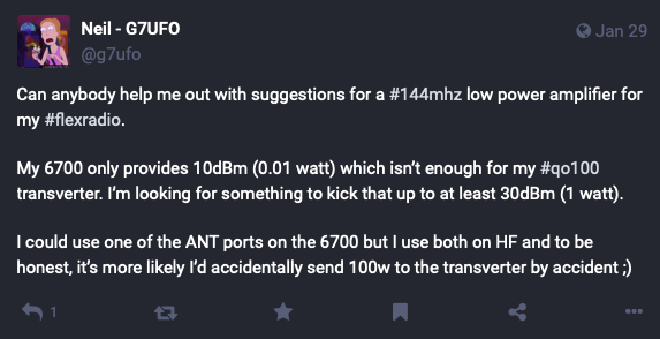
First up, I dropped a ’toot’ on Mastodon and then on the FlexRadio Community Forum. Thanks to everyone who replied.

Charlie, KB8CR suggested the Downeast Microwave 1WTR. I ordered one of these but unfortunately DEM were not able to fulfil the order at that time.
Fortunately Boyan, LZ2BE posted that they were using the 10W broadband HF/6M RF power amplifier from 60dbm.com from their FlexRadio into a DX Patrol. Boyan explained they were under-driving the amp with 10dBm which supplies around 1W which is perfect. I dropped Paul, UU0JR at 60dbm.com an email and they were very helpful. An order was placed for the cased version and it arrived a few weeks later from Ukraine - while I was on holiday!
Interestingly Hans Christian, LA9AKA mentioned that when ordering their Groundstation from DX Patrol they mentioned to António they were going to use it with a FlexRadio and “he just removed an attenuator in the signal path”. I didn’t hear back about enquiring if I could make this mod myself but it would have been very handy.
Cables, cables, cables #
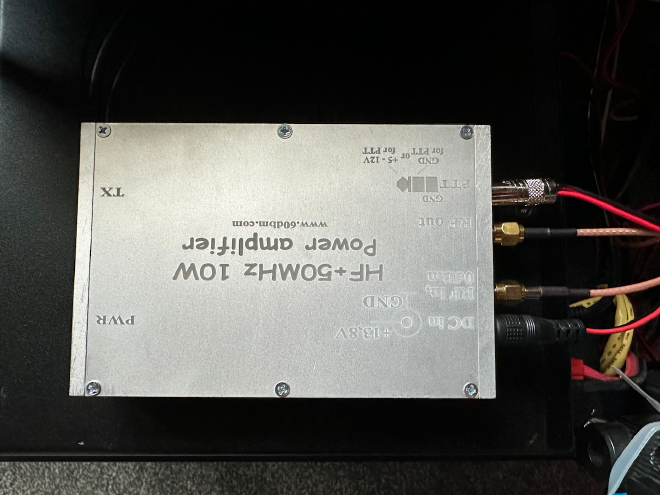
The 60dbm amplifier requires the usual 13.8V power, input and output cables. It also needs a TX trigger which is easily supplied from the back of the FlexRadio. The lead is a simple RCA to TRS lead connecting ground to the outer connector and the other cable to the middle pin.
The input to the amplifier comes from the XVTR port on the FlexRadio via a BNC to SMA RG316 short patch cable. The output goes into the Groundstation IF-TX/RX port via a SMA to SMA RG316 short patch cable. On my setup I’ve assigned TX2 to provide the TX trigger which is connected appropriately via a RCA to TRS cable.
The RX port (remember, full duplex) from the Groundstation is connected to the RX_A port on the FlexRadio using another BNC to SMA RG316 short patch cable.

Groundstation #
The groundstation is set to TX on 6m (50.5MHz) and RX on 2m (144.5MHz).
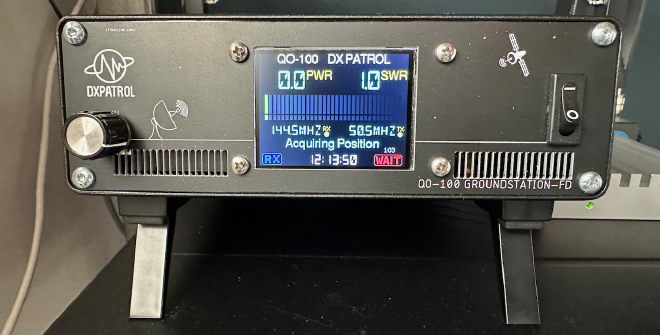
Configuring SmartSDR #
Transverters #
We need to create two transverters. One for TX and one for RX. The TX transverter will ensure we send 6m to the Groundstation and the RX one is a ‘fake’ but, like the TX transverter config, will allow us to display the real frequencies we’re working at.

| Name | RF Freq | IF Freq | Max Power |
|---|---|---|---|
| QOTX | 2400.000000 | 50.500000 | -10 |
| QORX | 10489.500000 | 144.500000 | 0 |
LO Erroris something which is unique to every setup. See the ‘Offset’ section below for how I calculated this.
TX Band Settings #
The image below is an edited version to show only the relevant bands. The two transverters we added above will appear here.
RCA TX2 is the PTT trigger which is grounded when we transmit. I’ve also set power to 0 and checked PTT inhibit on the QORX profile to help ensure we don’t accidentally transmit into the RX port of the Groundstation.

Band Plan #
SmartSDR offers to overlay band plans on the panadapter. This is available for QO-100 TX (2.4GHz) but not RX (10.4GHz). Lets enable what we have by selecting Sat QO-100 and checking Visible.
I’ve emailed the developer of SmartSDR to add this for RX

To add a bit more context to my panadapter, I’ve added a bunch of memories which better denote parts of the transponder (uplink and downlink). If you’d like to merge these with your existing memories then please grab the CSV file here.
Profiles #
Before we setup panadapters its worth creating a Global Profile for the QO-100 setup. I’ve named mine
QO-100 Groundstation Mac. Once we’ve set up the panadapters below we’ll save this so we can easily get to the same setup again.

Panadapters #
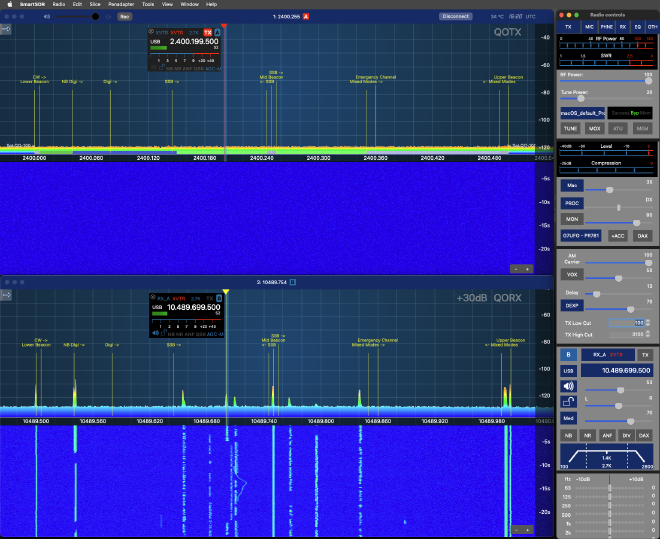
Now we’re using the QO-100 Groundstation Mac profile, create two panadapters and configure them as below.
| Panadapter | Band | TX Antenna | RX Antenna | TX | Muted? |
|---|---|---|---|---|---|
| 1 | QOTX | XVTR | XVTR | Enabled | Yes |
| 2 | QORX | XVTR | RX_A | Disabled | No |
Don’t forget to ensure you have FDX (Full Duplex) enabled.
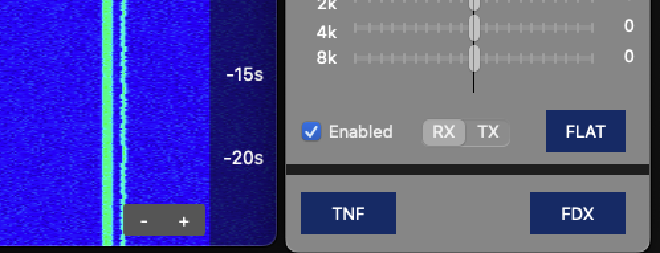
Now, go back to Global Profiles and save these updates.
Offset #
The Groundstation is GPSDO locked so TX should be at least consistent. If you find its slightly off-frequency then you can update the LO Error in the Transverters section.

TX #
- Navigate to the Goonhilly QO-100 WebSDR and pick a clear frequency.
- Tune the TX of your FlexRadio to that frequency and transmit your callsign and that you are testing.
- Mute the FlexRadio so you can only hear the WebSDR.
- Note how far off frequency you are and make adjustments in the Transverter panel for QOTX until you’re on frequency. Always check the frequency on the panadapter as updating in the Transverter panel updates this.
RX #
- Ensure your RX downlink matches your TX uplink eg: 10489.950GHz and 2400.450GHz.
- Transmit your callsign and that you are testing Ensure you can hear yourself on the downlink.
- Note how far off frequency you are and make adjustments in the Transverter panel for QORX until you’re on frequency. Always check the frequency on the panadapter as updating in the Transverter panel updates this.
If you’re using a DX Patrol LNB (or any other LNB which accepts the 25MHz LO from the Groundstation) then this shouldn’t need to be adjusted again.
I’m currently using a Bullseye LNB which is pretty stable but on occasion it needs a readjustment.
Slice Lock #
In SmartSDR you can set two slices to track each other. This is useful when you’re working cross-band as we are here. The RX will track your TX frequency.
The downside of this is that you’ll need to manually disable this when you’re not using QO-100 as its a global setting and not configurable per-profile. I don’t use this, instead favouring a Node Red flow do do this.
The value for Offset (Hz) is 8089500000 (10489500000 - 2400000000).
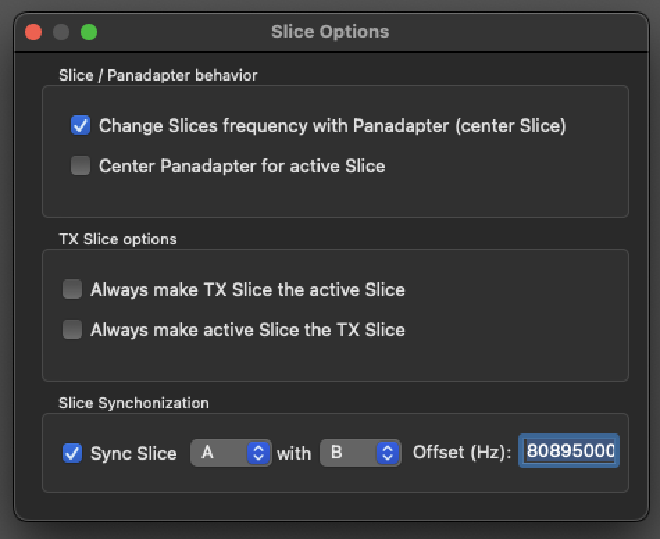
Node Red #
As mentioned above I’ve put together a Node Red flow to manage the following when I’m using the FlexRadio on QO-100.
- Sync slice A and B (TX and RX).
- When tranmitting, reduce the RX volume slighly. I can’t concentrate hearing myself with a few milliseconds difference at full volume!
- Some config confirmation like:
- Mute slice A (TX)
- Ensure slice B (RX) is not muted
- More stuff to come (eg: ensuring TX is enabled on slice A and disabled on slice B)
- Send a ‘Radio’ API call to my Cloudlog instance with current TX frequency, RX frequency, mode, SAT mode details.
I’ll put a post together detailing that soon!